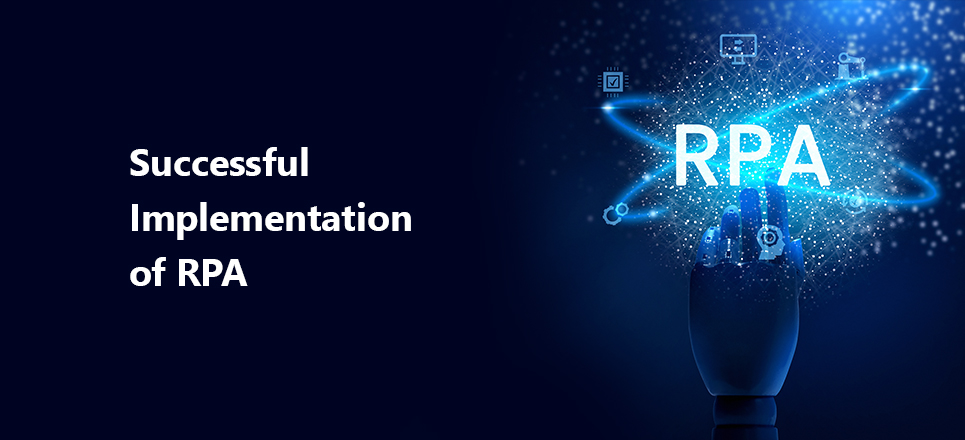Successful Implementation of RPA
In the wake of digital transformation, automation has been making inroads across all industries and domains. Against this backdrop, the demand for Robotic Process Automation (RPA) solutions such as AssistEdge RPA software has sky-rocked in recent times with the companies bound to implement the solution to compete and stay afloat in the business game. With RPA receiving a lot of attention in recent times, it has taken a leap forward to transform the dynamics of business operations for its capabilities to reduce the cycle time, enhance accuracy and productivity, and better regulatory compliance.
What is RPA?
RPA is a technological solution for automating manual business procedures to allow organizations to stay competitive and flourish in the technological landscape. By combining automation with artificial intelligence, organizations can restore numerous rule-based, repetitive, and human operations. The application of RPA solutions like AssistEdge RPA software will lead to faster, more secure, and more reliable services.
EdgeVerve Systems’ AssistEdge RPA Tool
EdgeVerve Systems’ AssistEdge RPA Tool offers end-to-end automation with Artificial Intelligence (AI) and OCR (Optical Character Recognition) resources. It predicts alerts about bot performance and service level agreement (SLA) failures that allow businesses to stay ahead of any issues. The business intelligence dashboards consist of data on both historical performance and forecasting with actionable insights. Additionally, it also incorporates enterprise-grade security and access features, together with GDPR compliance and assimilations with CyberArk’s Credential Vault. AssistEdge has over 120 operations, including the blend of RPA with email bots and chatbots.
Benefits of Using RPA Services
The top RPA service providers offer the below services that benefit enterprises:
Quicker Delivery of Task
The RPA tools and bots can complete tasks faster than humans, thereby improving process efficiency and nullifying bottlenecks.
Documentation and Compliance
RPA services are deemed the best bet for tracking, recording, and documenting data in a single cloud-based repository, creating audit trails, and upholding regulatory rules with precision.
Accuracy and Reliability
These software robots minimize human errors and their costs, thereby creating reliable, efficient, and accurate outcomes.
Enhanced Employee Confidence
Employees are relieved of redundant tasks and find enough bandwidth to focus on the more value-added roles that require expertise and knowledge.
Successful RPA Implementation Ideas
Strategic Planning
For RPA implementation in an organization, it is essential to understand the objectives to be fulfilled. The techniques and procedures applied should be coherent. The RPA implementation requires a decent plan for establishing change management. This step defines the roles of the employees around RPA implementation. A good and thorough plan can help the company address issues before the RPA is executed.
Preparing the Employees
Once the preparation is accomplished, the organization should prepare the employees to withstand the pressure of the introduction of automation. Educating and training them well may help the company and the employee achieve accurate estimated outcomes. Additionally, if employees are aware of the amount of ROI RPA brings, they will be able to capitalize on the use of RPA software.
Create Logical ROI Expectations
Deciding ROI and time taken for its realization is the most challenging thing to do for RPA implementation. The processes may get bigger with some complications within them. Hence, this would require precise administration, understanding of exceptions, and seasonality. Once these factors are analyzed well, improvements can be targeted. Likewise, the expense of RPA enactment can also be efficiently lessened.
Identifying Process that Requires Automation
This is one of the most significant roadmaps for successful RPA implementation. In this stage, a company finds out the processes which can be automated. Depending on this, organizations can take complete advantage of RPA. Some questions one can think before RPA implementation are:
- Can you take up processes which are steady and predictable?
- Are there any procedures that have fewer exemptions and do not necessitate human involvement?
- Can we find out the processes that are highly regular and provide quicker ROI?
- Establishing such processes can help you implement RPA productively
Teaming up with IT and Business teams
Once the processes that need RPA automation are decided, establishments must form relevant teams which should consist of people from the company’s IT and business departments. The team members must work in unison to successfully implement and use RPA. Lack of collaboration between these teams can lead to failure of RPA application. RPA can function successfully only if these teams collaborate and work in cohesion.
Implement RPA Successfully
Once an RPA roadmap is developed, the organization can head towards successful implementation. The roadmap involves documentation of RPA opportunities and project planning that facilitates an improved insight of the technology behind automation. Additionally, it can help you to see how RPA can be employed in various other business domains, which can lead to highly effective solutions.
Conclusion
The implementation of RPA can be tough and complex if it is executed without accurate planning and allotment of tools and resources. In the absence of these, the implementation of RPA can be a daunting and an intricate task. Thus, with an RPA automation professional at the disposal of the organization, it can reduce the burden that will also check failures and tricky anomalies. Hence, the application of all these RPA processes will lead to faster, more secure, and more dependable business services.

